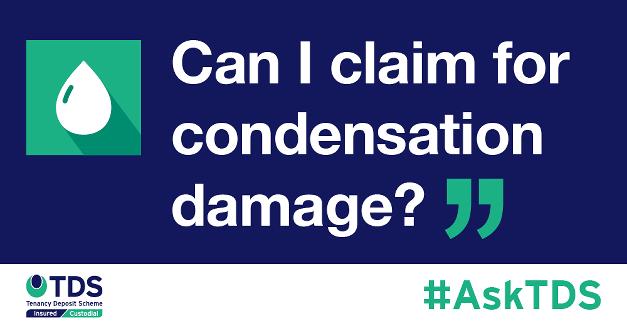#AskTDS: "Can I claim for condensation damage?"

This article has been written in response to a landlord’s query: “Can I claim for condensation damage?”
At the end of a tenancy, if a landlord or agent proposes deductions from the tenancy deposit it is important that the parties try to reach an agreement before raising it as a dispute with TDS.
Disputes concerning condensation damage are fairly common and TDS are often asked by both landlords and tenants what evidence needs to be supplied to support or respond to these claims. When presenting any case for a dispute, it is important to supply the key documents relating to the tenancy such as the tenancy agreement (including a clear deposit clause outlining what the deposit can be used for) and any check-in, check-out or inventory reports. These reports should clearly show an adjudicator any differences in the contents or condition of a property between the start and end of a tenancy.
In order to support a claim for any decoration or damage that is believed to have been caused by condensation, the landlord would need to evidence that this issue was a result of the tenant not abiding by their responsibilities relating to maintaining the property, such as not sufficiently ventilating the property. When the inventory report is carried out, the clerk should clearly detail the condition of all areas of the property, including walls and ceilings. This means that any symptoms of existing condensation, mould or damp should be raised prior to the tenancy commencing. These symptoms could include issues such as blackening/spot marks to the paintwork and flaking paint.
If a tenancy commences, without these issues being resolved, they should be clearly noted on any inventory and check-in report and provided to both the landlord and tenant to ensure that both parties are aware of the existing condition and it can’t be disputed at the end. To further minimise the opportunity for dispute in this area, it is advised that both parties should sign the relevant inventory/check-in report. Dated photographs should also be included in pre-tenancy evidence.
What does an adjudicator look for?”
When reviewing a case, adjudicators consider a number of questions for each part of the claim. These include: what the claim is for, how much is being claimed, what were the tenant’s obligations and did they fail to meet those obligations, was there any loss to the landlord or agent (allowing for fair wear and tear) and what evidence has been provided to quantify the loss. When putting forward a claim, landlords and agents should ensure their application answers all these questions to help give the adjudicator all the information they need.
When submitting evidence to TDS, remember that an adjudicator can only make decisions based on the evidence provided; they will not contact any of the parties for extra information or supporting evidence. It is therefore important to make sure that when submitting a dispute, you are fully outlining the deductions with supporting evidence for each of the claims. Ensure that the tenancy agreement supports the claim that is being made in addition to the pre-tenancy inspection and end of tenancy reports. TDS has created a ‘deductions template’ to help parties present their evidence in a clear and comprehensive way.
About TDS:
Tenancy Deposit Scheme (TDS) is a government approved scheme for the protection of tenancy deposits; TDS offers both Insured and Custodial protection and also provides fair adjudication for disputes that arise over the tenancy deposits that we protect.
We provide invaluable training in tenancy deposit protection and disputes for agents and landlords through the TDS Academy as well as joining with MOL to provide the Technical Award in Residential Tenancy Deposits.
TDS Insured Scheme: where a TDS member can hold the tenancy deposits as stakeholder during the term of the tenancy. (link to custodial)
TDS Custodial Scheme: where TDS hold the deposit for the duration of the tenancy. (link to insured)
TDS Academy: TDS provides property professionals with invaluable training in tenancy deposit protection and tenancy deposit disputes.
TDS can only comment on the process for our scheme, other deposit protection schemes may have a different process/require different steps. Content is correct at the time of writing.